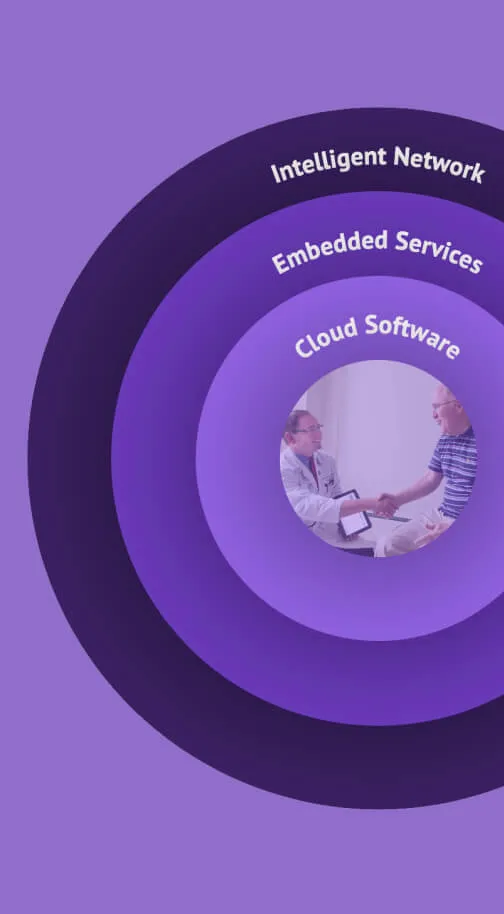What is a patient portal?
A patient portal (sometimes called a medical portal or health portal) is a secure website and/or app that enables patients to access personal health records and other information, communicate with their physicians and care teams, self-schedule and adjust appointments, view test results, request prescription refills, and access timely and relevant educational materials pertinent to their health. Patient portals have become a standard offering for most practices and healthcare organizations in the US and are now an important component in patients' experience with their healthcare providers.
The use of patient portals––typically offered to patients by healthcare providers via a healthcare IT partner––has increased dramatically over the past decade. According to a brief from The Office of the National Coordinator for Health Information Technology (ONC), the share of individuals who were offered and accessed online health records or a patient portal more than doubled between 2014 and 2022. This rise in usage is likely due in part to the increased availability of patient portals: roughly 3 in 4 individuals in the US were offered online access to their medical records by their health care provider or insurer in 2022, a 24 percent increase since 2020.1
That's great news for patients, who are benefiting from more access to their healthcare information and building stronger connections with their physicians and care teams.2 It's equally great news for healthcare providers, who stand to benefit in a variety of ways by making a patient portal available to patients and using it to its full potential.
Healthcare portals a key element of patient-centered care
Patient portals deliver clear benefits to patients, including easy access to health and clinical information and a direct line of communication to care teams. However, these technology tools also benefit healthcare providers in a variety of ways.
Let's look at some of the key value-adds patient portals deliver to healthcare providers striving to deliver more patient-centered care.
Enhanced communication with patients
One of the most obvious benefits of patient portals is improved communication. Patient portals serve as a secure, user-friendly communication platform for efficient messaging between patients and care teams. By providing this increased access, physicians and care teams can build more personalized connections with patients and extend their interactions to a secondary digital setting.
Using a portal, providers can respond to patient inquiries, provide guidance, and address concerns asynchronously, without the need for an additional phone call or in-person visit. Providing some level of care in this way can also help manage scheduling densities and relieve some administrative burden from physicians and staff.
One best practice for communicating via patient portals, as outlined by the American Medical Association, is for physicians to educate their patients on how they plan use the portal and set some guidelines for usage, including which types of topics are best suited for discussion via a portal, how quickly patients should expect a response to their questions, and which member of the patient’s care team will respond to inquiries.3
Streamlined appointment management
Managing daily appointments is a never-ending task, especially when done manually. Patient portals add considerable value in this area by providing patients with the ability to self-service for their scheduling and re-scheduling needs, and automation to streamline the process overall.
Here are a few of the top benefits patient portals deliver around appointment management.
- Self-service scheduling: Patient portals enable providers to offer online appointment scheduling, rescheduling, and cancellation options, without the need for patients to contact office staff. This reduces administrative burdens, improves scheduling efficiency, and allows staff to focus more on patient care and other practice needs.
- Patient acquisition: Some patient portals help make attracting new patients more seamless by enabling new patients to schedule an appointment without an existing login. With this capability, practices can include a link in marketing materials to reach prospective new patients and those looking for better appointment availability.
- Patient retention: A patient portal that offers quick access to practice schedules and an easy (and mobile) way to book an appointment can also help with patient retention. By offering an easy-to-use self-service portal, practices make it easier for patients to get an appointment at their convenience, which will hopefully also keep them coming back.
Improved care coordination
Many patient portals are integrated directly within a more comprehensive healthcare IT platform, specifically those with robust electronic health record (EHR) capabilities. Using this kind of health portal can provide great advantages for care coordination.
Specifically, patient portals have proven to promote better rates of follow-through on referrals, which are typically tracked within a patient’s health records and accessed via a patient portal. Patients who log into their patient portals are 20% more likely to access a referral; those who look at the portal and also open notes left by their care teams are 40% more likely to do so.4 This means that a patient portal, when used to its full potential by both patients and providers, not only builds better connections between a primary care provider and their patients, but it also improves connections with specialists and broader care teams.
Efficient and accurate prescription management
Prescription management is a very important responsibility for which accuracy is paramount. It can also be time consuming and prone to data-entry errors when done manually.
With many patient portals, providers can receive prescription refill requests, review medication lists, and send electronic prescriptions, all through the platform. Using this portal capability can greatly streamline the prescription management process and potentially reduce errors associated with manual documentation.
Patient engagement and empowerment
One of the best outcomes providers can hope for when offering a patient portal is that their patients become more active and engaged in their own care. A medical portal can promote this engagement in a variety of ways.
Patient portals typically provide patients access to a wide variety of educational resources, personalized care plans, and self-management tools. Patients who take advantage of these resources are, by definition, more engaged in their own care and more empowered to make decisions pertaining to their overall health. This engagement can lead to improved patient satisfaction, closer adherence to treatment plans, and—most importantly—better overall health outcomes.
Meeting patients where they are at
Patient portals are just one of the many healthcare IT tools making healthcare more accessible and convenient for patients.
They are also helping physicians do their jobs more efficiently, enabling them to focus time and attention on providing excellent patient care.
Offering an excellent digital experience for patients (in the form of a patient portal) is a great way for healthcare organizations to meet their patients where they’re at while delivering the best care possible.
Boost patient engagement with athenaOne
athenaOne is a comprehensive healthcare IT platform offering innovative capabilities and services for electronic health records (EHR), revenue cycle management, and patient engagement. The athenaOne patient portal is fully integrated with the platform, giving patients the ability to access their health information, message their care teams, self-schedule and check-in, and much more. With the athenaPatient mobile app, patients can do many of these things at their convenience using a mobile device.
With athenaOne, healthcare organizations can provide their patients with an easy-to-use portal that supports better patient engagement, streamlines a variety of important processes, and contributes to better, more patient-centric care.
- The Office of the National Coordinator for Health Information Technology (ONC), Individuals’ Access and Use of Patient Portals and Smartphone Health Apps, 2022, Oct. 2023; https://www.healthit.gov/data/data-briefs/individuals-access-and-use-patient-portals-and-smartphone-health-apps-2022
- National Library of Medicine, JMIR Hum Factors, Using Patient Portals to Improve Patient Outcomes: Systematic Review, Dec. 2019; https://www.ncbi.nlm.nih.gov/pmc/articles/PMC6940868/
- AMA, What doctors wish patients knew about using a patient portal, June 2022; https://www.ama-assn.org/practice-management/digital/what-doctors-wish-patients-knew-about-using-patient-portal
- AMIA, Jan. 2024, Do patients who read visit notes on the patient portal have a higher rate of “loop closure” on diagnostic tests and referrals in primary care? A retrospective cohort study; https://academic.oup.com/jamia/article-abstract/31/3/622/7504885?redirectedFrom=fulltext; IS087












